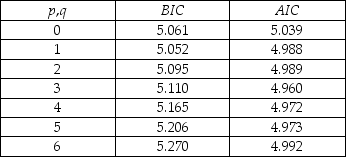Having learned in macroeconomics that consumption depends on disposable income,you want to determine whether or not disposable income helps predict future consumption.You collect data for the sample period 1962:I to 1995:IV and plot the two variables.
(a)To determine whether or not past values of personal disposable income growth rates help to predict consumption growth rates,you estimate the following relationship.  t = 1.695 + 0.126 ΔLnCt-1 + 0.153 ΔLnCt-2,
t = 1.695 + 0.126 ΔLnCt-1 + 0.153 ΔLnCt-2,
(0.484)(0.099)(0.103)
+ 0.294 ΔLnCt-3 - 0.008 ΔLnCt-4
(0.103)(0.102)
+ 0.088 ΔLnYt-1 - 0.031 ΔLnYt-2 - 0.050 ΔLnYt-3 - 0.091 ΔLnYt-4
(0.076)(0.078)(0.078)(0.074)
The Granger causality test for the exclusion on all four lags of the GDP growth rate is 0.98.Find the critical value for the 1%,the 5%,and the 10% level from the relevant table and make a decision on whether or not these additional variables Granger cause the change in the growth rate of consumption.
(b)You are somewhat surprised about the result in the previous question and wonder,how sensitive it is with regard to the lag length in the ADL(p,q)model.As a result,you calculate BIC and AIC of p and q from 0 to 6.The results are displayed in the accompanying table:
 Which values for p and q should you choose?
Which values for p and q should you choose?
(c)Estimating an ADL(1,1)model gives you a t-statistic of 1.28 on the coefficient of lagged disposable income growth.What does the Granger causality test suggest about the inclusion of lagged income growth as a predictor of consumption growth?
Definitions:
Benefits To Consumers
Refers to the advantages or improvements in well-being and satisfaction that consumers experience from purchasing and using goods and services.
Externalities
Monetary consequences that reach beyond the primary parties, impacting others positively or negatively.
Tax
An essential fiscal demand or variant form of duty exacted from a taxpayer by a governmental institution, intended to sustain government expenditure and miscellaneous public financial requirements.
Externality
An economic side effect of a good or service that generates benefits or costs to someone other than the person deciding how much to produce or consume.
Q8: (Continuation of the Purchasing Power Parity question
Q11: Volatility clustering<br>A)is evident in most cross-sections.<br>B)implies that
Q14: Here are some examples of the instrumental
Q19: In time series data,it is useful to
Q20: Consider the following earnings function:<br>ahei= β0 +
Q21: Consider the standard AR(1)Yt = β0 +
Q22: A peer of yours,who is a major
Q37: The reduced form equation for X<br>A)regresses the
Q42: Your textbook used a distributed lag model
Q55: The following statement about the sample correlation